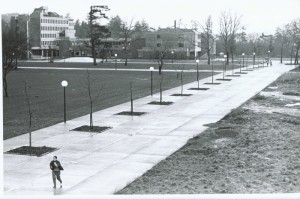During the ’50s and ’60s, architectural firms changed Victoria’s structural environment with modern planning and new architectural forms. Coinciding with Victoria’s 150th anniversary and UVic’s 50th anniversary, The Emergence of Architectural Modernism 2 exhibition recognizes architectural leaders and the post-war design relationships between Victoria’s urban landscape and UVic’s architectural design.
The sequel to last year’s exhibition further explores the design relationships that link Centennial Square and UVic. The exhibit displays planning initiatives, design projects, and building programs, including the exhibit highlight: architectural models of Victoria’s City Hall and UVic’s MacLaurin Building.
Curator Martin Segger is a UVic English honour student, 30-year faculty member and City of Victoria alderman; he says he’s seen a lot of changes at UVic over the years.

“I came to Victoria 35 years ago and attended the University of Victoria when it was just a small school of 1,000,” he says with a laugh, “and I’ve watched it grow to a university of almost 40,000.”
Inspired by his lifelong commitment to UVic and work with the City of Victoria Heritage Advisory Committee, he designed the exhibit to share Victoria’s important architectural history with the local community.
“Victoria’s modern architectural heritage is important for Victorians to understand,” says Segger. “Its Edwardian heritage and architectural aesthetic is often overlooked. What the City of Victoria represents is history inspired by a combination of early British settlers followed by post-war California architects.”
Architectural Modernism showcases Victoria’s modern movement, influenced largely by the international San Francisco architectural firm Wurster Bernardi Emmons, who were both campus planners for UVic and architectural advisors for Victoria Mayor Biggerstaff Wilson.
Victoria’s unique variation on the themes of modernism is valued as a representation of the city’s postwar growth. Segger says that two styles are evident; the two combined have come to be known as the West Coast Style.
“There’s a Victorian European international style, also known as New Brutalism, which consists of monumental clean line construction and a California postwar style that moves away from art-inspired construction to a more urban style,” he says.
People going to the exhibit will gain a new awareness of the social, historical, and architectural value Centennial Square and UVic carry in the development of our modern age.
“Understanding of the true value in these buildings has been progressive in the Capital Region,” says Segger. “It’s hoped that the exhibition will influence their preservation for future generations.”
The Emergence of Architectural Modernism 2
Until February 26
Legacy Art Gallery, 630 Yates
legacygallery.ca
